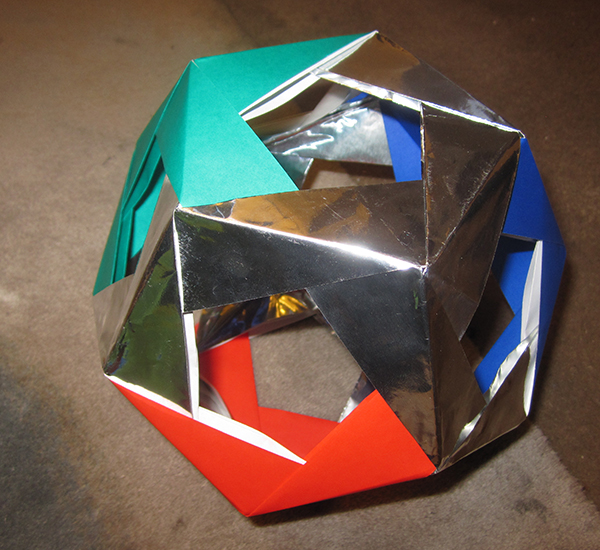This is a monthly feature wherein I show off my origami skills, mourn my photography skills, and talk about math. I primarily do modular origami.

A dodecahedron made of 108 degree modules, apparently invented independently by Robert Neale and Lewis Simon.
I think this is a fairly simple model, since it comes from Beginner’s Book of Modular Origami Polyhedra. But once I tried to teach it to kids, and it’s not a great model to teach to kids, trust me.
What is modular origami? I take many squares of paper, and I fold each of them into a module, aka a unit. Usually, the modules are all identical. Then I assemble all the units into a model, usually based on geometrical shapes. Traditionally, no glue or scissors are used in assembly.
The geometrical shape here is a dodecahedron. A dodecahedron is a platonic solid with 12 pentagonal faces, 30 edges, and 20 vertices. Each unit corresponds to an edge, and so there are 30 units.
Since these are regular pentagons, each unit has to have 108 degree corners. Of course, if you actually do the math, you find that the corners are closer to 108.435 degrees. This is okay, because origami space is non-euclidean, kind of like R’lyeh.
Some stuff that you can’t tell from the photo: this thing is a monster. It’s 7 in (18 cm) in diameter. I used 5 green squares, 5 blue squares, 5 red squares, and 15 squares of silver foil. The symmetric arrangement of these colors is left up to the imagination, since I certainly don’t have the photographic skill to capture it.

Very cool!
First, nice origami. I used to love doing it but have slacked off in recent years.
Re photography skills, one major trick I learned when I was writing manuals at one of my jobs (instructions on how to disassemble something):
The built-in flash is your enemy; they create unnatural shadows and reflections. The main problem with turning off the flash is that you have to hold the camera steadier to accomodate the longer exposure time.
A tripod helps a lot. Even if you can’t place it on a solid surface, it gives you more to grab onto. I have a little 10″ tripod that works in most situations. In a pinch, you can also steady yourself with a stack of books, wall, or furniture.
Also, a direct light source is non-optimal. If possible, bounce the light off a wall, ceiling, or even a sheet of paper (bristol board works well). To look natural, the bulk of the light should come from a direction that the sun could come from (i.e. lighting from below looks weird unless you’re going for a deliberate effect).
If you’re trying to protograph something moving (like a kid), you still probably need the internal flash, unless you have professional equipment.
@Golgafrinchan Captain,
The problem I run into without flash is that I’m often taking these late at night, and the lighting in my room is very yellowish. This is especially a problem with trying to capture colors. The best solution is to wait for daytime but I don’t always put in the effort.
But thank you for the tips, I could probably fiddle around with ideas next time. I’ve been trying to become more conscious of the photography as an important component of the art–but I don’t post these in chronological order so in many cases I’m stuck with the bad photography in any case.
Are you familiar with Tomoko Fuse? She’s one of the big names in the modular origami field, having written books on ‘Unit Origami’ and multiple books on ‘Origami Boxes’ which use similar concepts.
I used her books with designs for square, hexagonal, and octagonal boxes (though the 8-sided box was made from 4 sheets of paper, including two sides per sheet) and derived from the basic folding patterns marks for pentagonal and heptagonal boxes. Of course, then I discovered that boxes with even numbers of sides are much easier to assemble after the fact because you can assemble two halves and slide them together, whereas a box with an odd number of sides needs to be assembled from all sides at once.
(My heptagonal box used one sheet for each colour of the rainbow, while the pentagonal box used a gradient pink colour to produce what was supposed to be a cherry blossom effect.)
If you’re lucky, your camera might have a setting for different light sources. You can also supplement your other lights with an LED flashlight (blue-heavy) bounced off the ceiling, assuming you have a white ceiling.
I also use a free program called IrfanView which has a great auto-colour-adjustment.
Note: none of this was to complain about your photo, it looks good to me. It’s just because of your “mourn my photography skills” comment.
@Jenora Feuer,
Yes, I have a copy of Unit Origami! Not Origami Boxes though. What I really like about Tomoko Fuse is that her designs are very customizable. She invites the folder to imagine new possibilities that she herself did not lay out.